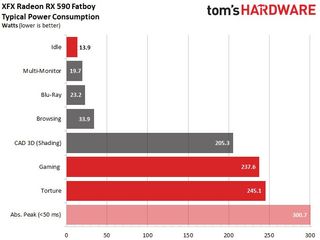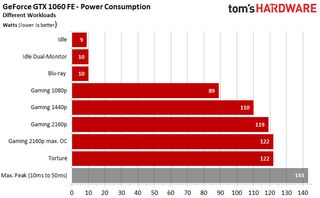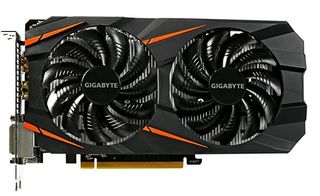AMD Radeon RX 590 vs. GeForce GTX 1060: Which Mid-Range GPU is Better?

Nvidia has the high-end GPU market cornered, but when the price drops below $300 (£249), AMD's Radeon RX cards match or exceed the offerings from Team Green. With prices as low as $279 (£249), the new AMD Radeon RX 590 GPU takes the mid-range Nvidia GeForce GTX 1060 cards head-on. That's why we decided to put the two platforms through a no-holds-barred face-off based on features, performance, power consumption and value.
Featured Technology
Why you can trust Tom's Hardware
AMD’s Radeon RX 590 graphics card is meant to fill the gap between the AMD RX 580 and the AMD Radeon RX Vega 56, which Nvidia’s GeForce GTX 1060 currently occupies. The RX 590 is based on the latest revision of AMD’s Polaris architecture, which debuted in June 2016, but is the first consumer card to use the company's 12nm FinFET manufacturing process. By shrinking the transistor size, the company’s engineers were able to ramp up the clock speed to pull more performance out of the old Polaris 10 platform.

Aside from changing the manufacturing process, AMD didn’t introduce any new technologies with the Radeon RX 590. It offers the same video decoding hardware found in the AMD Radeon RX 480, and it supports AMD’s WattMan tuning technology, which dynamically adjusts the GPU's parameters, such as clock speed, voltage and fan speeds to achieve the best possible balance of performance and power efficiency.
The Radeon RX 590 features 8GB of GDDR5 with 256GB/s of memory bandwidth. And it can produce up to 7.1 TFLOPS of 32Bit floating point performance with its 2304 shader cores clocked at 1469MHz base / 1545MHz Boost.
Nvidia’s current sub-$300 (~£249) GPU offering isn’t new either. The GeForce GTX 1060 with its GP106 GPU was first introduced in the spring of 2017, but the company has revised the specifications of its mid-tier offering several times since it’s introduction. There are three different GTX 1060 6GB configurations, including the original with 8 Gbps GDDR5 memory, a revised edition with 9 Gbps GDDR5, and a newly revealed version with GDDR5X memory.
Nvidia’s GeForce 1060 6GB features 1,280 CUDA cores with a 1506 MHz base clock and a 1708 MHz boost clock. Our MSI GeForce GTX 1060 Gaming X 6G features even higher clock speeds of 1595 MHz base and 1810 MHz boost. And the card’s 6GB of memory features 194.6 GB/s of memory bandwidth.

We haven’t tested the revised 9Gbps GDDR5, and the new GDDR5X GTX 1060 cards (nor have we seen one on the market), so this comparison focuses on the original GeForce GTX 1060 6GB and AMD’s new Radeon RX 590, which may skew the results slightly in favor of AMD. But we don't expect the faster memory of Nvidia's newer 1060 to make a substantial frame rate difference in most games.
Winner: AMD. AMD’s Radeon RX 590 offers higher memory bandwidth, more memory capacity, and the GPU is built on a smaller, more efficient manufacturing process than Nvidia’s GeForce GTX 1060. That said, as we'll see later, the Nvidia card pulls a lot less power.
Gaming Performance
When you’re buying a graphics card, the most important criteria is the card’s ability to run the games that you want to play at smooth frame rates. AMD’s Radeon RX 590 takes the company’s Polaris architecture to new levels of performance. The RX 590 consistently outpaced Nvidia’s GeForce GTX 1060 in our test suite, with several games, including Battlefield 1 (DX12), Far Cry 5, Tom Clancy’s The Division and Wolfenstein II, rendering at more than 10 frames per second (fps) higher with AMD's card.
There was one notable exception to the RX 590’s superior performance: The GTX 1060 rendered GTA V at 10 fps faster than our RX 590 could manage. However, the RX 590 took that lead when we bumped the resolution to 2560x1440. Evidently, GTA V likes the extra memory and the higher memory bandwidth that the RX 590 offers. The GTX 1060 also fared better than the RX 590 in Destiny 2, but the gap was within a few fps.
Both the RX 590 and the GTX 1060 offer ample performance for 1080p resolution gaming, and both cards can handle 1440p, but if you want to game at the higher resolution, an RX 590 is a superior choice because it can maintain a higher average framerate in most titles.
Ashes of the Singularity (DX12): 1920x1080 Results







Ashes of the Singularity (DX12): 2560x1440 Results







Battlefield 1 (DX12): 1920x1080 Results







Battlefield 1 (DX12): 2560x1440 Results







Destiny 2 (DX11): 1920x1080 Results







Destiny 2 (DX11): 2560x1440 Results







Far Cry 5 (DX11): 1920x1080 Results







Far Cry 5 (DX11): 2560x1440 Results







Grand Theft Auto V (DX11): 1920x1080 Results







Grand Theft Auto V (DX11): 2560x1440 Results







Metro: Last Light Redux (DX11): 1920x1080 Results







Metro: Last Light Redux (DX11): 2560x1440 Results







Shadow of the Tomb Raider (DX12): 1920x1080 Results







Shadow of the Tomb Raider (DX12): 2560x1440 Results







[Note that we didn't re-publish our full gaming test results here, because dozens of charts would overwhelm this single-page story. For all our gaming results, spread across 11 pages, head to our Radeon RX 590 review.]
Winner: AMD. The Radeon RX 590 is the clear winner here. In almost all cases, AMD’s new GPU outpaces Nvidia’s GeForce GTX 1060, and the performance disparity grows larger on titles that take advantage of the superior memory capacity and bandwidth of the RX 590.
Don’t Overlook Power Consumption
Nvidia’s GeForce GTX 1060 doesn’t quite match the performance of the Radeon RX 590, but Nvidia’s cards carry a 120-watt TDP and usually draw less power than that, whereas our RX 590 sample pulled more than 230 watts from the wall while gaming. That’s a tremendous difference in power draw, which results in higher operating costs for the AMD card over time.

If you don’t pay for electricity, the power draw won’t make much of difference to you, and you’d be better off prioritizing sheer performance. If you’re like most of us, and you pay for electricity by the Kilowatt, you should consider the additional costs of running AMD’s newest GPU.
To put it into perspective, if you spend 24.5 hours per week gaming (3.5hrs per day), a Radeon RX 590 will use approximately 294 kilowatt hours (KWH) in a year, whereas a Nvidia GeForce GTX 1060 6GB would draw approximately 166 KWH in that same period. The national average for electricity in the U.S. is 12 cents per KWH, which would amount to roughly $20 to operate the GeForce card and $35 to run the Radeon.

$15 throughout a year isn’t a major difference, but when you consider that most people keep their GPUs for multiple years, the amount of money you spend on power through the lifespan of your card could be the difference between buying a mid-tier GPU and a low-level upper-class GPU.
There’s also the power supply consideration: The specifications for Nvidia’s GeForce GTX 1060 call for a 400-watt power supply (note: our sample GPU requires a 500-watt PSU), whereas you’ll need at least a 500-watt PSU to run an RX 590. That said, you’re probably better off avoiding a 400-watt power supply for a modern gaming computer.
Winner: Nvidia. In order to take the Polaris architecture to the next performance threshold, AMD cranked up the dial on the power delivery system, which results in much higher power requirements.
Value Proposition
Nvidia’s GeForce GTX 1060 is built on Nvidia’s Pascal GPU architecture, and it was a great value when it first hit the market. Now that AMD has a strong rival at the same price point, Team Green’s offering is much less attractive. You can find examples of GTX 1060 6GB cards for as little as $21, which would be a great bargain and worthy of your attention. But some GTX 1060 models sell for upwards of $300, which is a bit rich for our liking. AMD’s new RX 590 slots right in the middle at $279.
In the UK, the pricing is a little bit different. The cheapest 6GB GTX 1060 that we found in the UK sells for £229, with some models going for as much as £319. Radeon RX 590 models range from £249 to £279.




Winner: Tie. Despite the high-power draw of the Radeon RX 590, it offers better performance for your money compared to Nvidia’s GeForce GTX 1060—even after you consider the extra cost of electricity. However, if your budget is tight, a $220 GTX 1060 6GB is a really hard bargain to beat.
Bottom Line
If you’re in the market for a graphics card and you have roughly $300 to spend, your best option right now is an AMD Radeon RX 590. But the best option isn’t always a good option.
There’s a term in chess called Zugzwang, which is when you’re forced to make a bad move for lack of any other option. The options available in the mid-tier GPU market feel somewhat like a Zugzwang. You can purchase a GTX 1060, which is the cheaper option, but offers inferior performance than the competition and is due for a 20-series replacement in the coming months. Or you can purchase an RX 590, which is effectively a rehash of a 3-year-old platform with the power limits pushed to their maximum.
Both options are sub-optimal, and we’d be somewhat inclined to suggest waiting to see what Nvidia is cooking up for the mid-tier market, but with the tariff increases coming in January, what is now a $300 graphics card could soon become a $375 graphics card, in which case you’d be better off buying what you can get now. And with Nvidia’s recent track record of increasing the price of cards on the high-end of the GPU hierarchy, who’s to say what the price of the 1060’s replacement will be?
| Round | Nvidia GeForce GTX 1060 6GB | AMD Radeon RX 590 |
| Featured Technology | Row 1 - Cell 1 | ✗ |
| Gaming Performance | Row 2 - Cell 1 | ✗ |
| Power Consumption | ✗ | Row 3 - Cell 2 |
| Value Proposition | ✗ | ✗ |
| Total | 2 | 3 |
MORE: Best Graphics Cards
MORE: Desktop GPU Performance Hierarchy Table
MORE: All Graphics Content
Stay on the Cutting Edge
Join the experts who read Tom's Hardware for the inside track on enthusiast PC tech news — and have for over 25 years. We'll send breaking news and in-depth reviews of CPUs, GPUs, AI, maker hardware and more straight to your inbox.
Kevin Carbotte is a contributing writer for Tom's Hardware who primarily covers VR and AR hardware. He has been writing for us for more than four years.
Most Popular




